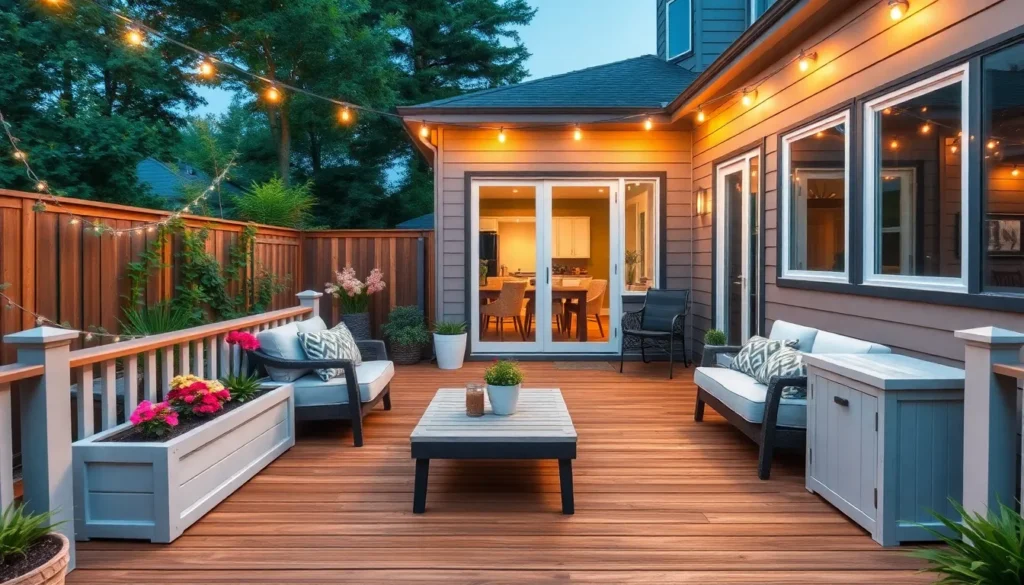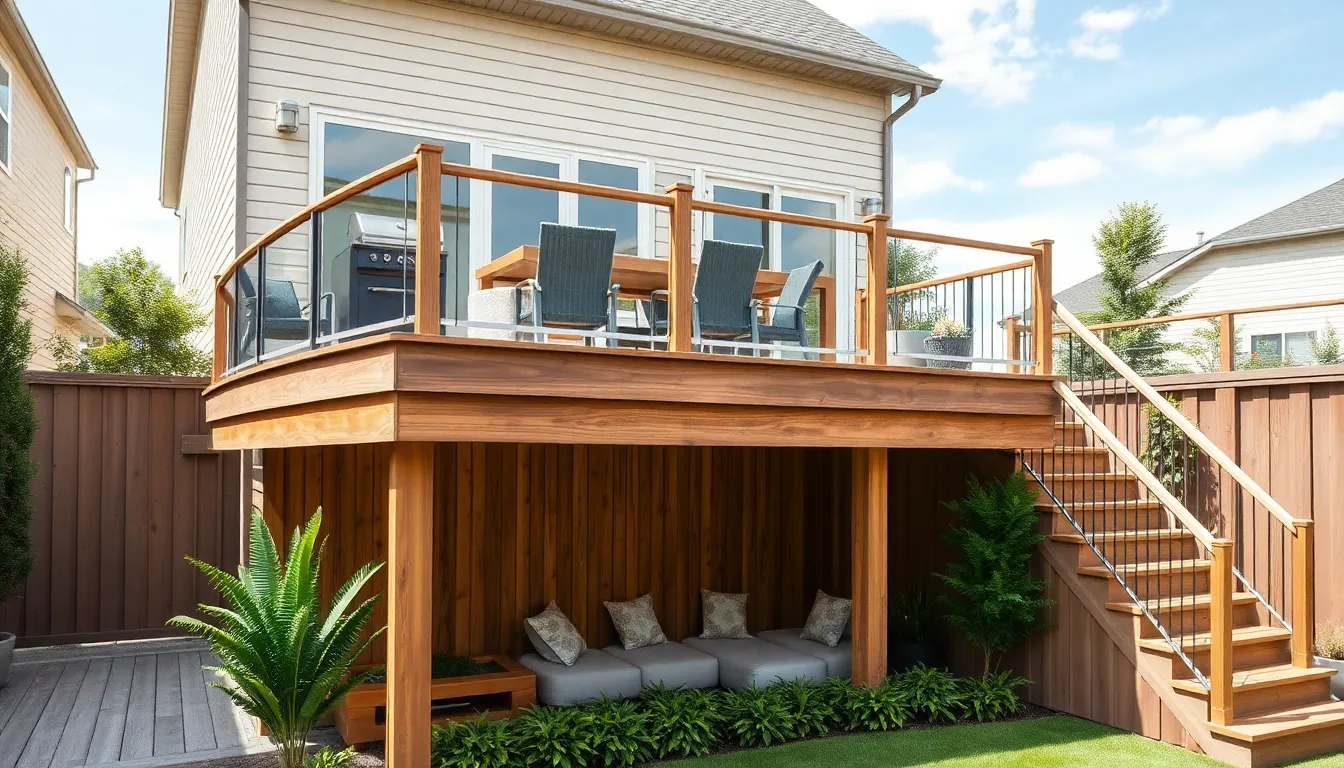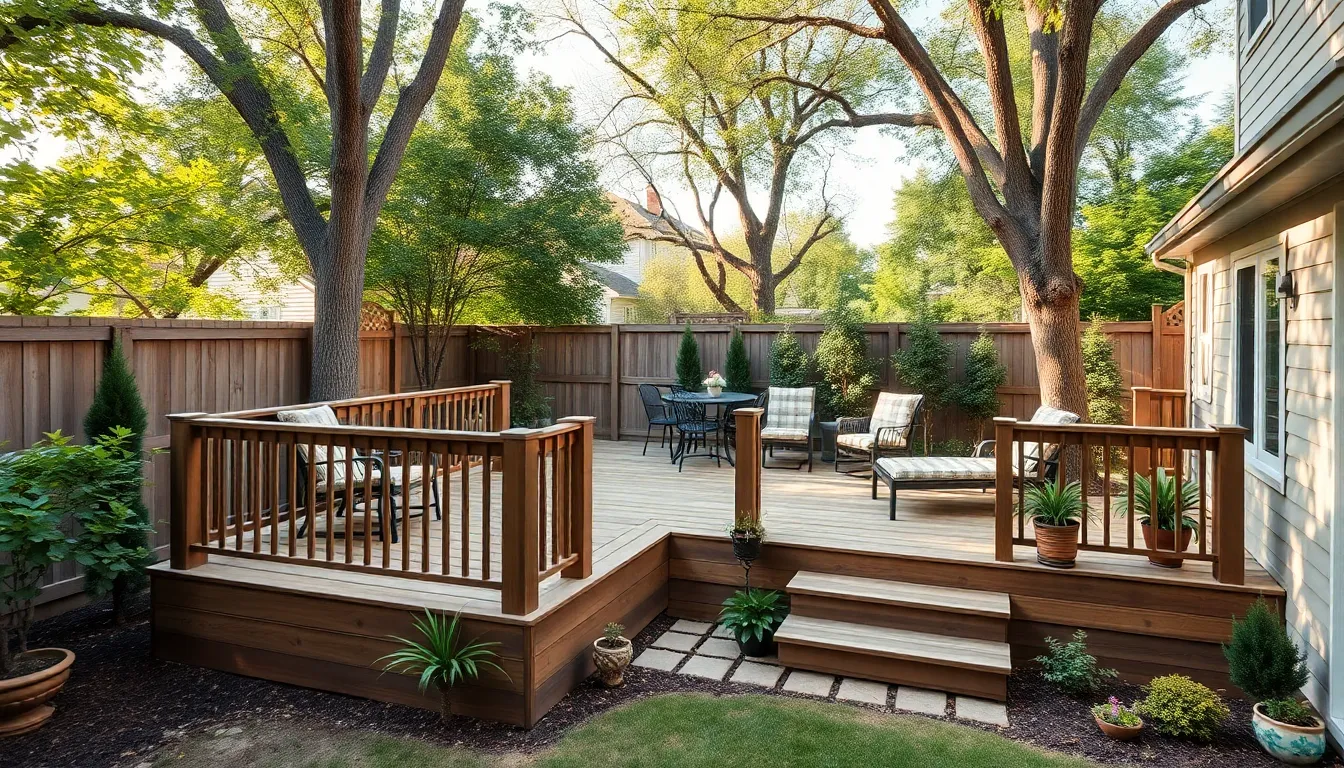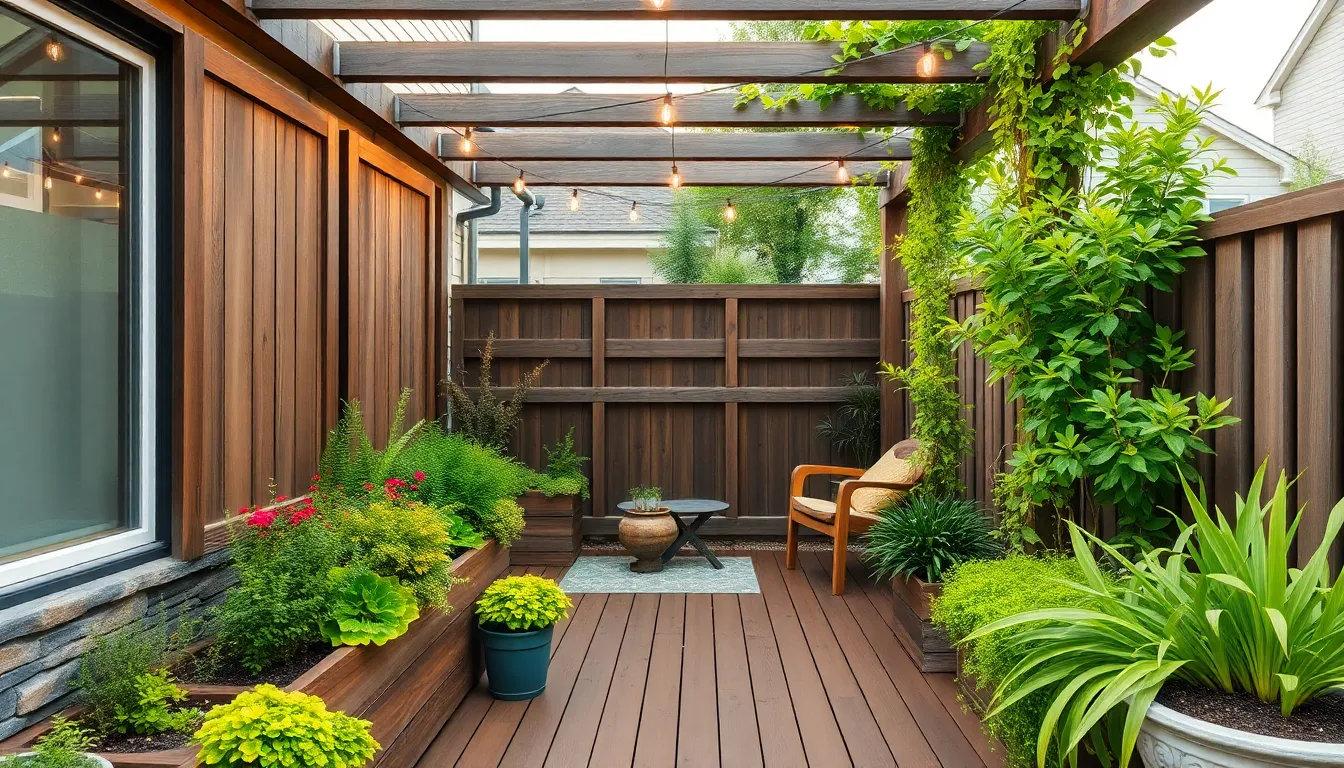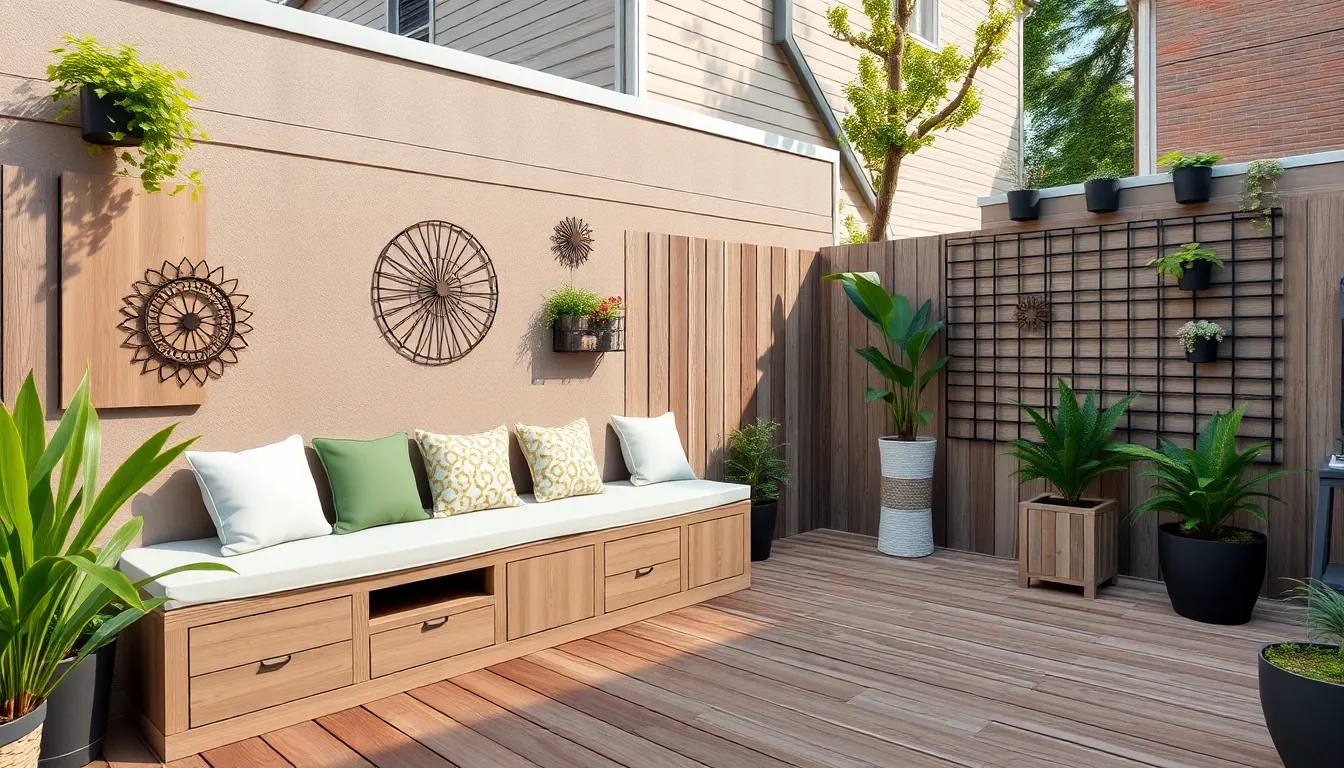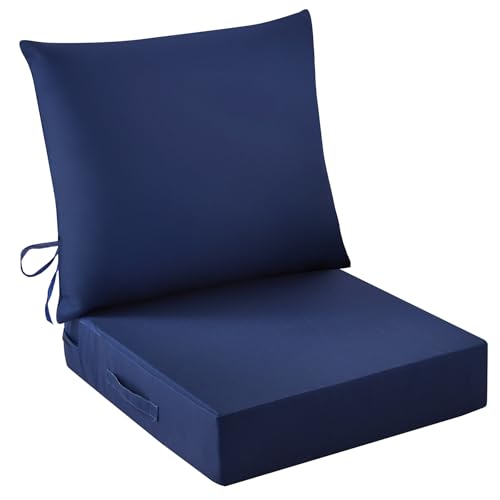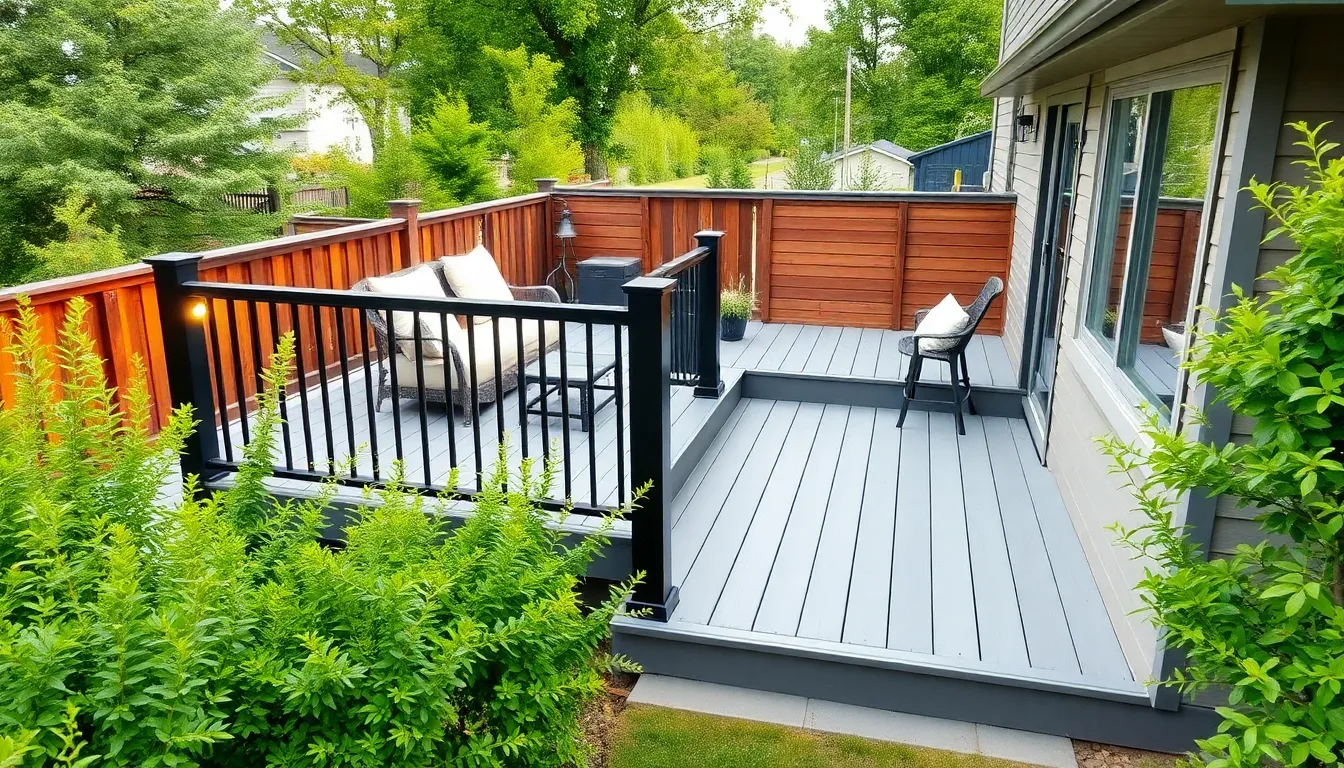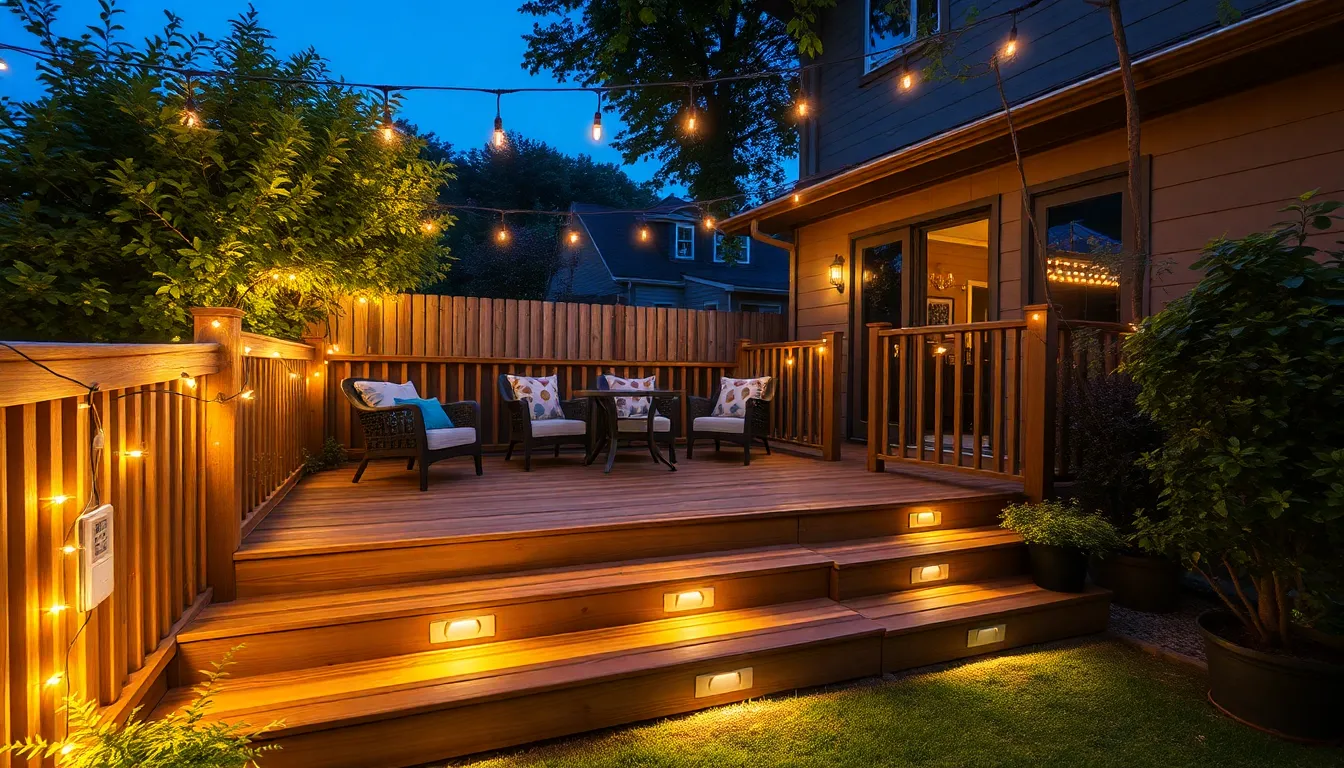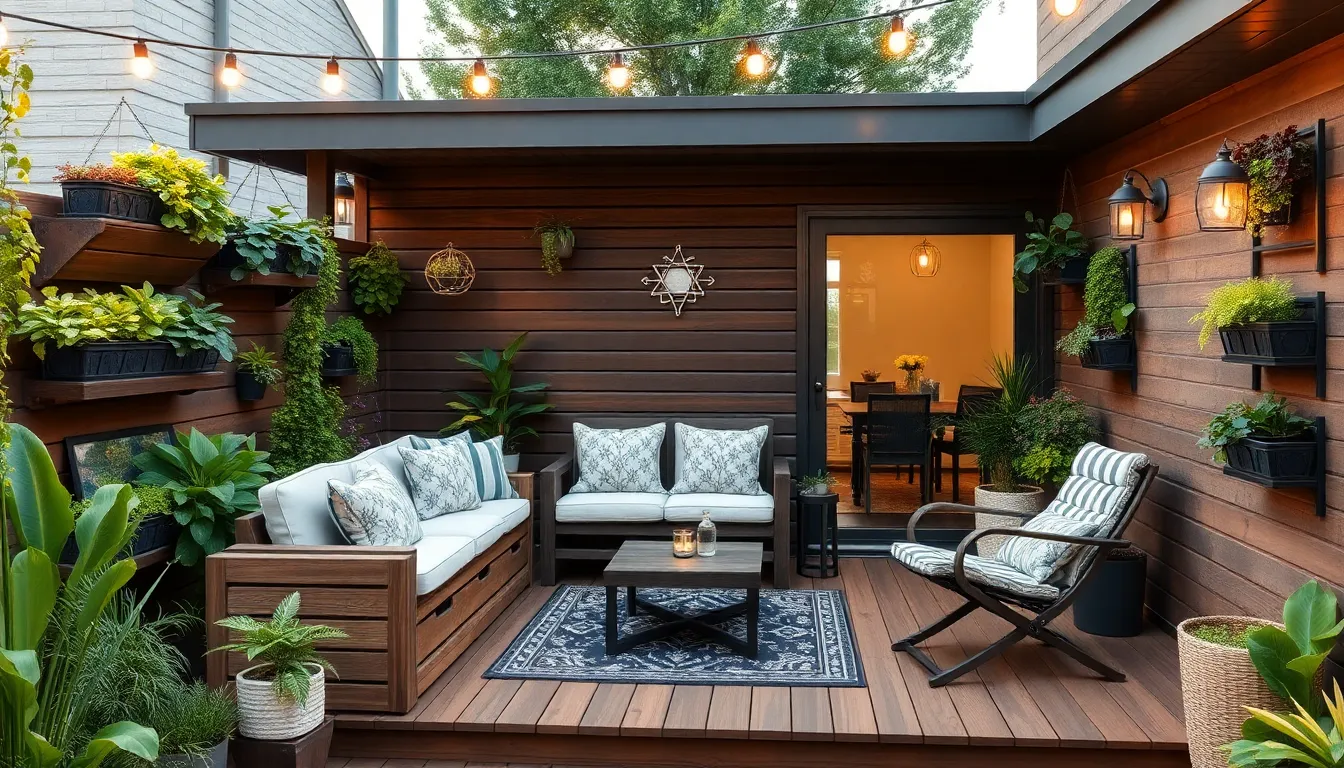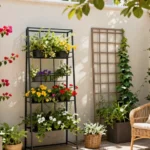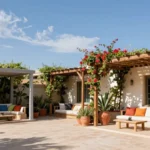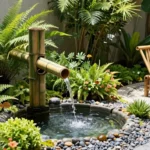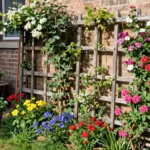We’ve all dreamed of having that perfect outdoor space where we can unwind after a long day or entertain friends on weekend evenings. If you’re working with a small backyard, you might think your deck dreams are limited – but we’re here to prove you wrong.
Small backyard decks can pack just as much style and functionality as their larger counterparts. With smart design choices and creative answers, we can transform even the tiniest outdoor area into your personal oasis. Whether you’re dealing with an awkward corner space or a narrow strip behind your home, there’s a deck design that’ll maximize every square foot.
We’ll explore innovative ideas that make small decks feel spacious, from multi-level designs to built-in storage answers. These aren’t just pretty concepts – they’re practical approaches that real homeowners have used to create stunning outdoor retreats without very costly or overwhelming their space.
Floating Deck Designs That Maximize Limited Space
Floating decks offer the perfect solution for small backyards because they don’t require permanent foundations or complex structural connections to your home. We’ve found these versatile platforms create stunning outdoor spaces while working within the tightest constraints.
Ground-Level Floating Platforms
Ground level floating decks transform small yards into functional outdoor rooms without overwhelming the space. These platforms sit directly on adjustable pedestals or concrete blocks, making installation straightforward and budget-friendly. We recommend using composite decking materials for these low-profile designs because they resist moisture and require minimal maintenance.
Design benefits of ground level platforms include:
- Seamless integration with patios and landscaping
- Easy access for elderly family members and young children
- Natural flow between indoor and outdoor living spaces
- Simple installation process requiring basic DIY skills
Popular size options range from 8×10 feet to 12×12 feet, providing enough space for outdoor dining or relaxation areas. We’ve seen homeowners maximize these compact platforms by incorporating built-in planters along the perimeter or adding removable furniture pieces that serve multiple functions.
Raised Floating Decks With Storage Underneath
Raised floating decks create valuable storage space while maintaining a small footprint in your backyard. These elevated platforms typically sit 18 to 24 inches above ground level, providing ample room for storing outdoor equipment, cushions, and seasonal items. We’ve discovered this dual-purpose approach helps small yards stay organized and clutter-free.
Storage answers for raised floating decks:
| Storage Type | Capacity | Best Uses |
|---|---|---|
| Weather-resistant bins | 50-100 gallons | Pool supplies, garden tools |
| Built-in benches | 20-40 gallons | Cushions, outdoor games |
| Lattice enclosures | Custom sizing | Trash bins, lawn equipment |
| Rolling carts | 15-30 gallons | BBQ accessories, cleaning supplies |
Construction involves creating a frame system with pressure-treated lumber and securing it to concrete footings or adjustable pedestals. We suggest installing removable deck boards in sections to provide easy access to the storage area below. Adding lattice skirting or decorative panels conceals the storage space while maintaining an attractive appearance from all angles.
Multi-Level Deck Configurations for Small Yards
Taking your small backyard deck to the next level literally means embracing vertical space. These configurations maximize every square foot while creating distinct zones for different activities.
Two-Tier Deck Systems
Two-tier deck systems separate your outdoor space into functional zones without expanding the footprint. We recommend placing dining and BBQ areas on the upper tier while reserving the lower level for relaxation or garden access. This vertical approach creates better flow between activities and helps define different purposes within your limited yard space.
Composite materials with sleek railings work exceptionally well for these designs, emphasizing modern minimalism while providing durability. Your upper tier can accommodate a grill and dining table, while the lower section serves as an intimate seating area. This separation allows multiple activities to happen simultaneously without interference.
Corner Step-Down Designs
Corner step-down decks use yard corners efficiently while visually expanding your small space through tiered transitions. We’ve found these designs particularly effective when steps incorporate built-in storage or seating, making smart use of every available inch. Each tier creates a distinct functional zone, whether for intimate conversations or cozy fire pit gatherings.
Built-in storage within the steps themselves eliminates clutter while maximizing utility. Your corner design can include weather-resistant compartments for outdoor equipment or seasonal items. These configurations naturally guide traffic flow while creating multiple destination points within your compact yard.
Wraparound Multi-Level Layouts
Wraparound multi-level decks extend around one or two sides of your home, following natural terrain or architectural contours. We recommend this layout for creating seamless indoor-outdoor connectivity while maximizing usable deck surface without overwhelming your yard. Multiple levels allow you to work with existing grade changes rather than against them.
Built-in benches and integrated lighting enhance both utility and ambiance in wraparound designs. Your layout can separate social zones naturally, with quiet areas for reading and active spaces for entertaining. This configuration creates the illusion of more space by wrapping around your home’s exterior while maintaining proportional scale to your yard size.
Space-Saving Deck Shapes and Layouts
Strategic deck shapes can transform even the tiniest backyard into a functional outdoor oasis. We’ve discovered that certain configurations maximize every square foot while creating distinct zones for different activities.
L-Shaped Corner Decks
L-shaped corner decks make the most of awkward yard spaces by fitting snugly into corners without dominating the entire area. These designs create a cozy, defined outdoor room that feels intimate yet spacious enough for entertaining.
Functionality becomes the star with L-shaped layouts, as they naturally accommodate multiple zones like dining areas, lounging spaces, or even compact outdoor kitchens. We love how these shapes help separate different activities – you can have a quiet reading nook on one arm while maintaining a BBQ area on the other.
Integration with existing industry features works beautifully with L-shaped decks. They can wrap around garden beds, trees, or even HVAC units, turning potential obstacles into design elements that enhance your outdoor space’s flow.
Narrow Rectangular Designs
Narrow rectangular decks excel in tight spaces along your home’s side yard or against property lines where width is limited. These streamlined designs create functional outdoor corridors that don’t overwhelm small backyards.
Efficiency defines these layouts as they accommodate essential outdoor activities like grilling, small gatherings, or container gardening without sacrificing yard space. We recommend using lighter composite materials to make these decks feel more expansive and connected to your home’s architecture.
Flow improves dramatically with narrow designs as they create natural walking paths that connect different yard areas. Built-in railings that blend with your home’s style can make these compact decks feel like seamless extensions of your indoor living space.
Curved and Circular Deck Options
Curved and circular decks add organic architectural interest that softens the angular lines typically found around homes. These flowing shapes create a natural, oasis-like atmosphere that makes small yards feel more spacious and serene.
Visual appeal increases significantly with curved designs as they break up the predictable rectangular patterns common in outdoor spaces. We’ve found that circular decks work particularly well with integrated benches or built-in planters that follow the deck’s natural curve.
Space perception improves with these organic shapes because they eliminate sharp corners that can make small areas feel cramped. The flowing lines guide the eye around the space, creating an illusion of greater square footage while promoting a more relaxed, natural outdoor environment.
Vertical Design Elements That Add Visual Height
Small backyard decks can feel surprisingly spacious when we incorporate design elements that draw the eye upward. Smart vertical features create the illusion of height without expanding our deck’s actual footprint.
Built-In Planters and Garden Boxes
Built-in planters transform small deck corners into lush garden spaces while maximizing every square inch. We recommend installing tall rectangular planters along deck edges to create natural boundaries between seating areas and open space. Garden boxes integrated into the deck structure serve dual purposes by housing herbs like basil and rosemary while adding vibrant greenery to our outdoor room.
Corner garden boxes work exceptionally well for small decks because they use otherwise wasted space. Raised planters at varying heights create visual layers that make the deck appear larger and more ever-changing. We can grow cascading plants like trailing petunias or ivy in elevated boxes to add vertical interest without blocking sightlines.
Built-in herb gardens near seating areas provide both beauty and functionality for outdoor dining. Tall ornamental grasses planted in deck-integrated boxes sway gently in the breeze and create natural privacy screens. Custom planter boxes can incorporate built-in irrigation systems to keep maintenance simple and our plants thriving year-round.
Privacy Screens and Decorative Panels
Privacy screens create intimate outdoor rooms while adding architectural interest to small deck spaces. Decorative panels made from cedar or composite materials offer stylish answers that block unwanted views without making our deck feel closed off. Lattice patterns allow light and air to flow through while providing essential privacy from neighboring properties.
Geometric cutout designs in metal or wood panels create modern focal points that serve as both art and function. We can install screens at strategic angles to define separate zones within our small deck area. Vertical slat panels work particularly well for contemporary homes and can support climbing plants like clematis or morning glories.
Custom privacy screens can incorporate LED lighting strips for evening ambiance and year-round usability. Modular panel systems allow us to adjust privacy levels seasonally by adding or removing sections as needed. Combining different materials like wood and metal creates visual texture while maintaining our budget parameters.
Pergolas and Overhead Structures
Pergolas instantly transform small decks into defined outdoor rooms with clear boundaries and overhead interest. Even compact pergola designs measuring 8×8 feet can dramatically change how we experience our deck space. Overhead beams create natural anchor points for hanging plants, string lights, or outdoor curtains that add both function and charm.
Simple pergola structures provide essential shade during peak sun hours while maintaining an open, airy feeling. We can install retractable fabric panels on pergola frames to create flexible shade and weather protection. Climbing vines like grape or wisteria trained over pergola beams create living canopies that evolve with the seasons.
Contemporary pergola designs using steel or aluminum frames suit modern homes and require minimal maintenance compared to traditional wood structures. Corner pergolas maximize space efficiency by utilizing deck angles effectively. Built-in pergola lighting extends our deck’s usable hours and creates magical evening atmospheres for entertaining guests or quiet relaxation.
Smart Storage Solutions for Small Deck Spaces
Maximizing storage potential transforms cramped deck spaces into organized outdoor havens. We’ll explore three proven storage strategies that keep your small deck functional while maintaining its aesthetic appeal.
Under-Deck Storage Compartments
Under-deck storage compartments provide the most space-efficient solution for hiding outdoor essentials. Sliding storage drawers beneath your deck can house gardening tools, outdoor cushions, and kids’ toys while maintaining easy access. These compartments require waterproof and durable materials to withstand weather conditions year-round.
Concealing drawer fronts with matching deck materials creates a seamless visual flow that doesn’t interrupt your deck’s design. Wall-mounted hooks and small baskets underneath your deck offer additional hanging storage for garden tools, grilling accessories, and outdoor toys. Rail planters combined with storage baskets deliver both practical storage and decorative greenery, optimizing every inch of your deck’s vertical space.
Built-In Bench Seating With Storage
Built-in bench seating combines comfortable outdoor furniture with hidden storage compartments beneath the seats. This dual-purpose approach eliminates the need for separate storage units while providing essential seating for entertaining guests. Storage compartments can hold cushions, outdoor blankets, and other deck essentials without cluttering your limited floor space.
Space-saving furniture like folding chairs and ottomans with hidden storage complements built-in benches perfectly. These benches add a sleek, sophisticated appearance that enhances your deck’s functionality for both everyday use and special occasions. Incorporating storage seating creates organized outdoor living without sacrificing style or comfort.
Vertical Wall Storage Systems
Vertical storage systems use wall space efficiently while keeping your deck floor area completely clear. Wall-mounted hooks, shelves, and pegboards can store frequently used items like gardening tools, grill utensils, and outdoor equipment within easy reach. This approach proves crucial for compact deck spaces where every square foot matters.
Hanging baskets integrated with vertical planters provide storage capacity while maintaining decorative appeal through greenery. These systems transform otherwise unused wall space into functional storage that doesn’t compromise your deck’s visual appeal. Vertical answers ensure that your small deck remains uncluttered and spacious feeling even though limited square footage.
Budget-Friendly Materials for Small Deck Projects
Building a small backyard deck doesn’t have to expensive. We’ve identified three cost-effective material categories that deliver quality results while keeping your project within budget.
Composite Decking Alternatives
Composite materials offer exceptional value for small deck projects through their durability and minimal maintenance requirements. Modern composites like Trex and TimberTech mimic natural wood appearance while resisting rot and insect damage that can plague traditional lumber.
Gray composite decking with sleek black railings creates a minimalist aesthetic that blends seamlessly with natural surroundings. This combination delivers long-term savings through reduced maintenance costs compared to traditional wood options.
Trex decking with built-in storage and LED deck lights maximizes functionality in compact spaces while providing innovative lighting answers. These integrated features eliminate the need for separate storage purchases and electrical installations.
| Composite Brand | Initial Cost | Maintenance | Lifespan |
|---|---|---|---|
| Trex | Moderate | Minimal | 25+ years |
| TimberTech | Moderate | Low | 20+ years |
| Generic Composite | Lower | Low | 15+ years |
Reclaimed and Recycled Materials
Reclaimed wood adds distinctive character to small decks while supporting sustainable building practices. Salvaged lumber from old barns, warehouses, and demolished structures provides unique textures and weathered patinas that new materials can’t replicate.
Recycled composite decking combines environmental responsibility with practical benefits by incorporating post-consumer materials into durable deck boards. These products reduce waste streams while delivering composite material advantages like moisture resistance and dimensional stability.
Architectural salvage yards offer budget-conscious homeowners access to premium materials at fraction of retail costs. Reclaimed teak, cedar, and mahogany often cost 30-50% less than new lumber while providing superior aging characteristics.
DIY-Friendly Building Options
Pressure-treated lumber remains the most accessible option for DIY deck builders due to widespread availability and straightforward installation processes. Hardware stores stock comprehensive fastener selections and provide cutting services that simplify construction phases.
Simple deck designs with separate benches eliminate complex joinery requirements while maintaining functional outdoor living spaces. These straightforward layouts allow novice builders to complete projects using basic tools like circular saws, drills, and levels.
Classic decks with basic railings provide safety compliance without requiring specialized carpentry skills or expensive hardware systems. Standard railing kits from major manufacturers include detailed instructions and pre-cut components that streamline assembly processes.
Small decks with integrated storage offer DIY flexibility through modular construction techniques that don’t require professional expertise. Built-in planters, bench storage, and simple outdoor kitchen elements can be added incrementally as skills and budgets allow.
Lighting and Electrical Features for Compact Decks
Smart lighting and electrical additions can transform our small deck into a functional outdoor sanctuary that extends usability well into the evening hours.
Solar-Powered Lighting Answers
Solar powered lights deliver excellent value for compact decks since they require no complex wiring or electrical work. These energy efficient fixtures work perfectly in tight areas where running electrical conduit becomes challenging and expensive. Deck post lights create subtle perimeter illumination while step lights enhance safety along stair edges and transitions.
Pathway lights can define walkways and borders without consuming any electricity from our home’s grid. Solar technology has improved dramatically in recent years, with many fixtures now providing 8-12 hours of consistent illumination after a full day’s charge. We’ll find that solar deck lighting reduces utility costs to zero while offering the flexibility to relocate fixtures as our deck layout evolves.
String Lights and Ambient Lighting
String lights offer the most versatile approach to creating warm, inviting ambiance across our compact deck space. LED string lights consume minimal energy while delivering maximum visual impact when draped overhead between posts or nearby trees. Globe bulb styles provide classic elegance while fairy lights create a magical, twinkling effect perfect for entertaining.
Wrapping string lights around railings maximizes coverage without requiring additional mounting hardware. This installation method works especially well on narrow rectangular decks where overhead mounting points might be limited. We can layer different string light styles to create depth and visual interest, combining overhead canopies with railing accents for comprehensive ambient lighting.
Built-In Electrical Outlets and Fixtures
Built in electrical outlets transform compact decks into truly functional outdoor living spaces by powering essential equipment year-round. Weatherproof outlets integrated into railing posts or deck trim provide seamless access to power without compromising our deck’s clean aesthetic. These outlets enable us to operate outdoor speakers, portable heaters, fans, and seasonal decorations.
Recessed lighting installed in deck floors or step risers enhances safety while maintaining our limited square footage. Floor mounted fixtures illuminate pathways and seating areas without creating visual clutter above eye level. We should plan electrical installations during initial construction to minimize costs and ensure proper weatherproofing for long-term reliability.
Furniture and Decor Ideas for Small Deck Spaces
Choosing the right furniture and decor transforms our small deck into a stylish outdoor retreat that feels both spacious and inviting. Smart selection of pieces that combine form with function helps us maximize every square foot while creating a cozy atmosphere for relaxation and entertaining.
Space-Saving Outdoor Furniture
Multi-functional furniture pieces serve as the foundation for our small deck design strategy. Benches with built-in storage compartments provide comfortable seating while hiding outdoor cushions, gardening tools, and seasonal items underneath. Foldable chairs stack neatly against walls when we’re not entertaining guests, freeing up valuable floor space for daily activities.
Modular seating arrangements adapt to different occasions and group sizes without overwhelming our compact space. Separate wooden benches create intimate conversation areas that encourage family gatherings while maintaining visual openness. Low-profile furniture maintains the illusion of spaciousness by keeping sightlines unobstructed across our deck surface.
Compact dining answers like wall-mounted drop-leaf tables expand when we need them for meals and fold flat against railings when not in use. Corner seating units maximize awkward spaces that traditional furniture can’t use effectively.
Vertical Gardening and Plant Displays
Vertical plant displays add natural beauty without sacrificing precious floor space on our small deck. Wall-mounted planters create living walls that enhance privacy while bringing fresh greenery into our outdoor room design. Railing planters fit perfectly along deck edges, transforming safety barriers into decorative garden features.
Tiered plant stands use corner spaces efficiently, creating cascading displays that draw the eye upward and make our deck feel larger. These vertical arrangements accommodate herbs, flowers, and small vegetables in organized tiers that are easy to maintain and water.
Hanging planters suspended from pergola beams or ceiling hooks add greenery at eye level without touching the deck surface. Trellis systems attached to walls support climbing plants that create natural privacy screens while maximizing our growing space vertically.
Multi-Functional Decor Elements
Built-in features combine architectural beauty with practical functionality throughout our small deck space. BBQ grills with adjacent seating create dedicated cooking and dining zones that serve multiple purposes within our limited square footage. Stone pillar features blend natural elements with structural support, adding rustic warmth without creating clutter.
Lighting embedded in railings provides safety illumination while doubling as decorative accents that enhance our deck’s evening ambiance. Storage benches with cushioned tops offer comfortable seating during the day and secure storage for outdoor essentials at night.
Natural wooden elements serve as both structural components and decorative features, creating cohesive design themes that connect our deck with surrounding industry. Minimalistic design choices like sleek railings and subdued color palettes in gray composites and black accents keep our space feeling open and modern while maintaining sophisticated style.
Conclusion
Small backyard decks offer endless possibilities for creating beautiful outdoor retreats regardless of space limitations. We’ve shown you how smart design choices floating platforms multi-level configurations and strategic storage answers can transform even the tiniest yards into functional oases.
The key lies in maximizing every square foot through thoughtful planning and creative approaches. Whether you choose L-shaped corner designs vertical gardening elements or budget-friendly DIY materials each option we’ve explored proves that size doesn’t determine style or functionality.
Your small deck can become the perfect outdoor sanctuary with the right combination of space-saving furniture clever storage and ambient lighting. Start with one idea that resonates most with your vision and watch your compact outdoor space evolve into something truly special.
Frequently Asked Questions
What makes floating deck designs ideal for small backyards?
Floating decks are perfect for small backyards because they don’t require permanent foundations, making them budget-friendly and easy to install. They can be placed at ground level for seamless integration with existing patios or raised to create valuable storage space underneath. These versatile platforms can be customized with built-in planters and removable furniture to maximize functionality.
How can multi-level deck configurations maximize small outdoor spaces?
Multi-level decks utilize vertical space to create distinct zones for different activities within a small footprint. Two-tier systems can separate dining and relaxation areas, while corner step-down designs efficiently use awkward yard corners. Wraparound multi-level layouts enhance indoor-outdoor connectivity and create the illusion of more space through strategic elevation changes.
What deck shapes work best for tiny backyards?
L-shaped corner decks fit snugly into awkward spaces and create cozy outdoor rooms with multiple zones. Narrow rectangular designs work well for tight spaces, providing efficient outdoor corridors. Curved and circular decks offer organic appeal, soften angular lines, and enhance the perception of space while creating a more serene atmosphere.
How can vertical design elements enhance small deck spaces?
Vertical elements add visual height and functionality to small decks. Built-in planters and garden boxes maximize growing space while providing greenery. Privacy screens and decorative panels create intimate outdoor rooms with architectural interest. Pergolas and overhead structures define spaces, provide shade, and draw the eye upward to make areas feel larger.
What are the best storage solutions for small deck spaces?
Under-deck storage compartments utilize space beneath raised decks to hide outdoor essentials using waterproof materials. Built-in bench seating combines comfort with hidden storage compartments. Vertical wall storage systems maximize wall space to keep the deck floor clear and uncluttered, ensuring small decks remain functional and aesthetically pleasing.
Which materials offer the best value for small deck projects?
Composite decking alternatives like Trex and TimberTech provide durability and low maintenance while mimicking natural wood. Reclaimed and recycled materials offer unique character and sustainability at lower costs. DIY-friendly options with simple designs and accessible materials allow novice builders to create functional spaces without requiring specialized construction skills.
How can lighting enhance small deck functionality?
Solar-powered lighting provides cost-effective illumination without complex wiring, offering energy-efficient safety and ambiance. String lights create warm atmospheres for evening entertaining. Built-in electrical outlets and recessed lighting improve functionality and safety. These lighting solutions transform small decks into versatile outdoor living spaces usable well into the evening hours.
What furniture works best for small deck spaces?
Space-saving outdoor furniture like benches with built-in storage and foldable chairs maintain an open feel while maximizing functionality. Multi-functional pieces such as BBQ grills with adjacent seating serve dual purposes. Vertical gardening solutions including wall-mounted planters and tiered plant stands add greenery without sacrificing valuable floor space.

